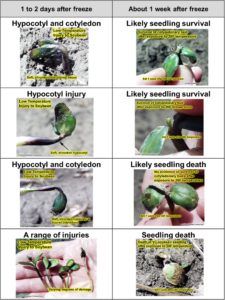Agronomic Update – May 9, 2020….Brrr….
2020 continues to be full of surprises…many of the ‘not-so-great’ kind. We are officially in a freeze warning for the next couple of nights. What will exactly occur from this, one can not be certain…however, I have included a nice summary from our area Pioneer agronomist, Kevin Kowalski, on what to possibly expect….and what to look for….over the upcoming next few days. This is specifically directed towards soybeans. A freeze won’t hurt corn as the growing point is below ground. However, the cold temps could still impact overall emergence and stands, as the plants will just ‘sit’ for the next few days leading to an increased chance for disease, etc. to impact the shoot, etc. Also, expect to see some cold imbibition to possibly occur on any corn that has just been planted. One positive from all of this, is that we currently do not have saturated soils. Saturated soils would increase substantially the impact from disease, etc. Also positive, is that our soil temperatures were very warm heading into this cold snap, so it take some time to lower the overall temps into the 40’s, which will help limit overall exposure.
Below are the comments from Kevin:
Accessing Freeze Damage on Soybeans:
If air temperatures drop to high 20s/low 30s freeze injury could be expected to soybeans. Soybeans in low areas of the field are most likely to be affected. Plants should be assessed for damage at least 5 days after suspected injury to inspect for regrowth. If damage occurred above the cotyledons, the plant will likely recover. If damaged occurred below the cotyledons, the plant will not recover. Look for a discolored hypocotyl (the “crook” of the soybean that first emerges from the ground) which indicates that damage occurred below the cotyledons. If soybeans were not yet emerged at the time of the freeze, they should be fine. Here are some pictures below to help guide you from Purdue U on frost damaged soybeans.
Some soybean key points:
- Emerged soybeans are more susceptible to damage from freezing temperatures than corn because their growing points are above the soil surface
- Several cool days can harden a plant and temperatures of 28 degrees can sometimes be better tolerated
- Temperatures below 32º F can cause frost damage to emerged soybean plants, while temperatures below 28º F for an extended period of time (>4 hrs) can be lethal, especially on lighter-textured soils.
- Heavier-textured soil can better store and release previously accumulated heat near the soil surface when air temperatures drop, helping to protect recently emerged soybean plants.
- High levels of residue on the soil surface can increase the risk of freezing injury by reducing the transfer of heat from the soil to the plants.
- A soybean plant at the cotyledon stage has three growing points –the main shoot and two axillary buds at the base of the cotyledons. Recovery from freezing injury is possible as long as at least one of these buds survives.
- Soybean seedlings that have just cracked the soil surface will be more tolerant to freezing temperatures than plants at the cotyledon or unifoliate stages.
- The cotyledons are full of solutes making them good buffers protecting the three potential growing points between them, making them more resistant to injury and therefore soybeans at VC stage are slightly more frost tolerant compared to V1-V2 stages
- Freezing damage that extends below the cotyledons will result in the death of the plant.


